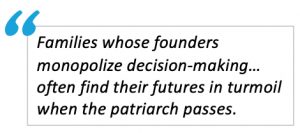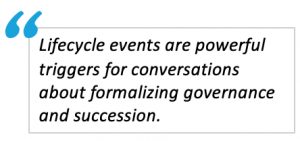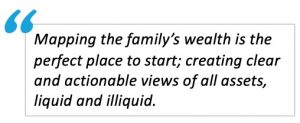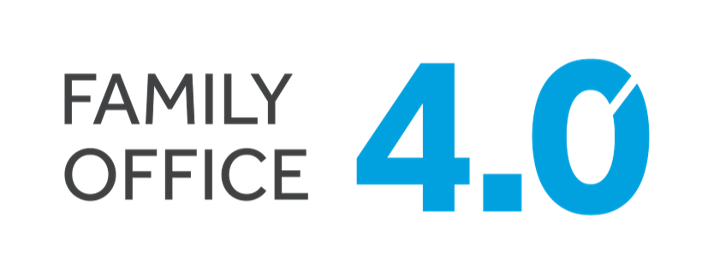Mirror, Mirror, on the wall,
Which Family Office has it all?
“A family office must mirror the family”, says EY Private’s Family Office Leader Ismael Hajjar, “by faithfully reflecting its interests”.
“This proverbial mirror can enhance what it sees by advancing the family’s priorities. Which is precisely what it will do, but only if it is professionalized”, adds Mr. Hajjar.
Why professionalize a family office by hiring seasoned talent, installing proven processes, and deploying advanced technology?
Simple: To protect and preserve the family through effective governance and succession planning.
The “Why” is easy. It’s the “How” that’s far more complex.
Here are the first five steps courtesy of a professional who knows them well: Ismael Hajjar, EY Private’s Family Office Leader for the Middle East/North Africa, where the typical family office is still at “square one” – an adjunct of the family business and often embedded within.
#1. Find Your Trigger: Use a pertinent event to trigger a conversation about protecting the family well into the future. For example, should the patriarch suffer the loss of a peer whose passing destabilizes that family, he might be spurred to take steps to protect his own clan from a similar fate – steps that would begin with the professionalization of his family office.
#2. Encourage Family Members to Speak-up: How to formalize decision-making and delineate ownership structures of family assets? What priorities should shape investment decisions and philanthropic choices? The most sustainable answers come from a family’s full participation.
#3. Mapping is Job One: How to begin? By creating 3 maps: one for the family comparable to a genogram, one for their objectives, and one of the wealth: a comprehensive, real-time, actionable views of all assets held worldwide, liquid, and illiquid, with a clear description of how they’re owned and identities of the ultimate beneficial owners.
#4. Providing for the Family’s Lifestyle is Job Two: Next, work on equipping the family office to enable the family’s lifestyle. Determine what members will need to live life on their terms; help pursue what interests them and delegate what doesn’t. Use these insights to equip the office with a menu of services, like recommending an organizational structure, providing professional leadership and support staff, and a technology suite. Let’s not forget that the Family expects the Family Office to give them back time and peace of mind!
#5. Select the Right Technology: Since protecting and growing wealth is a high priority, family-office technology’s purpose is to provide comprehensive views of all assets, real-time valuations, and historical changes in valuation that can inform predictive advantage. Look for secure, easy-to-use, transparently priced technology that delivers vital information when it’s needed: How did my equities perform last week? Has my real-estate portfolio been a profitable year to date? When is my next capital call due? And so on.
Why professionalize the family office? And how to do it?
Among family-office advisors, Ismael Hajjar stands out.
Why?
Because while many advisors can guide families to the proverbial mountaintop, where formal governance strengthens decision-making and succession, few start this journey where Mr. Hajjar does: at the base of the mountain – “square one” – where the family office breaks free of the family business to begin its ascent as a professionally-run entity.
Mr. Hajjar established the Middle East/North Africa (MENA) regional team of the award-winning practice in 2016 and is the EY MENA Private Family Office Leader – making him uniquely adept at helping family offices professionalize their businesses. And for good reason: It’s what he does every day, given that family offices across MENA are often at the earliest stages of development.
We spoke to him recently to garner insights into why and how to professionalize a family office. Here are highlights of our conversation:
Why professionalize a family office?
Mr. Hajjar: From investment to tax to regulatory compliance, every function of a family office is strengthened by the hiring of professional talent, the installation of proven processes, and the implementation of advanced technology.  But the first reason to professionalize a family office is to preserve the family itself through effective governance and succession planning.
But the first reason to professionalize a family office is to preserve the family itself through effective governance and succession planning.
The alternative is unsustainable: Families whose founders monopolize investment information and decision making – whose reliance on a small cadre of business lieutenants ignores the need to enfranchise family members – often find their futures in turmoil when the patriarchs pass.
How to trigger the process of professionalizing a family office? What’s the best approach?
Mr. Hajjar: The best approach is organic; meaning, with a conversation, triggered naturally.
Lifecycle events are often powerful triggers. For example, should the patriarch sustain the loss of a peer whose passing destabilizes that family, this would be an opportunity to start a conversation about professionalizing the family office to ensure a smooth succession? The same applies when sons and daughters study or work abroad and return home with new skills and a fresh mindset, hoping to apply what they’ve learned to help shoulder the burden of running the family office.
Events like these can trigger conversations that produce consensus on the need for strong governance, and on the value
of using external resources to achieve it. Indeed, we’re seeing more and more of these beautiful conversations culminating in consensus to professionalize. Why? Because families are realizing that governance agreements and succession plans cannot be enforced unless they’re legally binding. This creates the need for a family constitution and the professional tools needed to craft it.
Triggers can also emerge from popular culture. Consider “Succession,” for example – the television series about a fictional family-owned media empire where siblings are fighting for control amid uncertainty over the patriarch’s health. For many G2s, it crystallizes what they’re thinking but have yet to share with siblings and cousins: Why do battle when a smooth succession is achievable? Cultural triggers can also embolden them to speak.
Of course, the ultimate trigger for professionalization comes if the family business goes public or brings on board private equity, and the investors demand that it decouple the family office and formalize succession planning. 
The consequences for neglecting this responsibility can be severe: in one case, a global customer of a newly IPO’ed family business made its contracts contingent on having a succession strategy in place.
How to prompt professionalization of the family office? Activate a trigger, and the patriarch will typically see the need. And now that family constitutions can be legally enforced in the Middle East region, “they’re not worth the paper they’re printed on” has vanished as an excuse for inaction.
Once professionalization of the family office has been triggered, what then?
Mr. Hajjar: Have family members weigh in on how to define the relationship between the family and the family office. For example: How to formalize decision-making and delineate ownership structures? And what kind of identity to create? What one or two priorities will shape investment decisions and philanthropic choices?
We would start with this process by conducting one-on-one interviews with family members, whose findings we synthesize into a diagnostic report for family members and non-family leaders. Experience shows us that when this work is done by a neutral third party, family members are more inclined to offer their candid input and put more faith in the validity of the results.
This isn’t about bringing in consultants to hold the family’s hand. It’s about engaging a high performing team with the right experience and interpersonal skills to be on the family’s side; one skilled at creating a constitution that will transfer to family members tasks of increasing importance.
Step two is to look at the office holistically to determine its needs: What are the family’s requirements, how to design an org chart, tech stack, menu of services, and succession plan capable of meeting them? Once these questions are answered and used to create an operating framework, the family is ready to recruit the professionals who will constitute its support structure.
When it comes to support, mapping the family’s wealth is the perfect place to start; meaning, all assets held worldwide, liquid, and illiquid, with a clear description of how they’re owned and the identities of the ultimate beneficial owners.
 This is vital, especially in regions where family offices have yet to be professionalized. Here’s an example of why: A few years ago, we met a patriarch who had been granting loans to local entrepreneurs without documenting them.He had no lists, contracts, or documents of any kind; just several million dollar worth of loans secured by handshakes and recorded in his memory.
This is vital, especially in regions where family offices have yet to be professionalized. Here’s an example of why: A few years ago, we met a patriarch who had been granting loans to local entrepreneurs without documenting them.He had no lists, contracts, or documents of any kind; just several million dollar worth of loans secured by handshakes and recorded in his memory.
What comes next?
Mr. Hajjar: Once the mapping exercise has been completed, the next step is to determine how to equip the family office to enable the life of the family. This starts by determining what family members will need to live life on their terms; to do the things they want to do and delegate what they don’t. Knowing this is essential to build a foundation for the family office: by providing a menu of services, i.e, a professional leadership and support staff, an organizational structure, and a technology suite.
Because the best family offices produce appreciable benefits, EY Private prioritizes two palpable KPIs: time and peace of mind. Time is the big one: By relieving them of tasks they’d rather not do themselves – pay bills, book flights, deal with lawyers etc. – the family office gives its members more time to pursue their passions.
On the other hand, time is a curse without the serenity to enjoy it; the peace of mind that comes from knowing that one’s affairs are being handled with the highest degree of professionalism.
How is technology best applied to strengthen a family office?
Mr. Hajjar: Since peace of mind is the goal, family-office technology can have no greater purpose than to provide comprehensive views of all assets, real-time valuations, and historical changes in valuation that can inform predictive advantage. Also enabled by technology is the access to discrete information when and where it’s needed: How did my equities perform last week? Has my real-estate portfolio been a profitable year to date? When is my next capital call due? And so on.
But here’s the key: Don’t chase technology for the sake of technology. Pursue the right technology: secure, easy to use, transparently priced, and designed to give family members control of their data.
This article was contributed by EY Private’s Family Office Leader Ismael Hajjar, an Asset Vantage partner.
Speak to us and let us show you how AV can help you make better-informed decisions




